The Failure of Eco-Neighborhood Projects in the City of Madrid (Spain)
Abstract
:1. Introduction
2. Materials and Methods
3. Eco-Neighborhoods in the City of Madrid
4. Results of the Eco-Neighborhood Project in the Puente de Vallecas District in Madrid
4.1. Origins of the Nuestra Señora de Los Ángeles and San Francisco Javier Municipal Communities in the Puente de Vallecas District
4.2. The Sustainability as a Response to Housing Problems and Social Conflict
5. Conclusions
Author Contributions
Funding
Conflicts of Interest
Appendix A
| Three Dimensions of the Sustainability. Requirements | ||
|---|---|---|
| Environmental Components | Economic Basis | Social Matters |
| Closure of the water cycle: Efficiency in the consumption, optimization of the water distribution and purifying system, use of the flooding rain, etc. Comprehensive planning of free spaces in the city, green areas and ecosystem services. Irrigation control and gardening with plants that need little water (xerojardinería). Provide comfort and attraction to create public spaces. Pavement: Use of ecological photocatalytic pavements, permeable covers, etc. Waste management: Pneumatic waste collection, underground containers, etc. Mobility: Reduction in motorized journeys through an integrated network of footpaths and cycleways Building: Maximum exploitation of sunlight, good insulation, cross ventilation of rooms, thermal inertia, etc. Energy efficiency installations: A centralized system of power generation (natural gas, biogas, biomass) or energy self-efficiency buildings. District heating, cooling and hot water systems. | Appropriate density of population: to stimulate local trade, to access to centralized energy generation systems, etc. Compact urbanization morphology. Avoid dysfunctions of dispersed urbanization and favor the reduction of displacements through proximity of uses and accessibility. Economic activities diversity but with a balanced distribution of equipment and services and an integration of residential areas. Innovative economic base: Promotion of the circular economy that integrates retail and craft pre-existing trades with new incorporations. Creation of collaborative spaces, such as coworking spaces or makerspaces. Good access to the city center with public transport and reasonable connection with bordering areas and other neighborhoods. | Creation of conditions to establish social stability, and equal opportunities. Social diversity: Intergenerational, interethnic, interclass. With these purposes, to guarantee the mixture of housing tenure (property and rent), types (multi-family and single-family building), sizes and adapted for disabled or elderly people. To encourage public and private promotions. Identity and legibility: To build a friendly neighborhood, and improve the feeling of belonging. |
| Three Basis for an Optimal Development | ||
| Public Participation | Citizen Involvement | Multidisciplinary Involvement |
| Vertical involvement between authorities: Central government, autonomous regions and city councils. Different sources of funding and complementary subsidies. Horizontal involvement between entities that have the duty to cooperate: Housing, power, social inclusion and employment. | Consensus between public and private entities, residents, citizens etc. Participation of the residents in the design and management of the neighborhood. To urge social responsibility in a new culture of environmental sustainability. | To incorporate professionals of the design and construction sector (architects, urban planners, environment and ecology specialists, geographers) together with sociologists and social workers. |
References and Notes
- Boutaud, B. Quartier durable ou éco-quartier? Cybergeo Eur. J. Geogr. 2009. Available online: http://journals.openedition.org/cybergeo/22583 (accessed on 7 September 2018).
- Hernández Aja, A.; Velázquez, I.; Verdaguer, C. Ecobarrios para ciudades mejores. Ciudad y Territorio Estudios Territoriales 2009, 41, 543–558. Available online: http://oa.upm.es/5841/1/CyTET_161_162_543.pdf (accessed on 7 September 2018).
- Choguill, C. Developing sustainable neighbourhoods. Habitat Int. 2008, 32, 41–48. [Google Scholar] [CrossRef]
- Rohe, W.M. From Local to Global: One Hundred Years of Neighborhood Planning. J. Am. Plan. Assoc. 2009, 75, 209–230. [Google Scholar] [CrossRef]
- Mongil, D. Intervención integral en barrios: Conceptos, instrumentos y elementos de mejora. Ciudades 2010, 13, 139–161. [Google Scholar] [CrossRef]
- Rey, E. Quartiers durables. Défis et opportunités pour le développement urbain; Office Fédéral du Développement Territorial ARE/Office Fédéral de l’Énergie OFEN: Berne, Suisse, 2011; Available online: https://www.are.admin.ch/are/fr/home/media-et-publications/publications/developpement-durable/nachhaltige-quartiere---herausforderungen-und-chancen-fuer-die-u.html (accessed on 7 September 2018).
- Charlot-Valdieu, C.; Outrequin, P. Ecoquartier-Mode d’emploi; Editions Eyrolles: Paris, France, 2011; ISBN 212126018. [Google Scholar]
- Sturgeon, D.; Holden, M.; Molina, A. What does neighborhood theory mean for ecourbanism? Introduction to the themed issue on ‘Ecourbanism Worldwide’. J. Urban Res. 2016, 14. Available online: http://journals.openedition.org/articulo/3128 (accessed on 7 September 2018).
- Albors, J. La mejora urbana desde los barrios: Marco instrumental, intervención integral y oportunidades. In Ciudades en (re)construcción: Necesidades Sociales, Transformación y mejora de Barrios; Colección_Estudios—Diputació Barcelona: Barcelona, Spain, 2008; pp. 267–278. ISBN 978-884-9803-580-3. Available online: https://www1.diba.cat/uliep/pdf/42942.pdf (accessed on 7 September 2018).
- Sharifi, A. From garden city to eco-urbanism: The quest for sustainable neighborhood development. Sustain. Cities Soc. 2016, 20, 1–16. [Google Scholar] [CrossRef]
- Medved, P. A contribution to the structural model of autonomous sustainable neighbourhoods: New socio-economical basis for sustainable urban planning. J. Clean. Prod. 2016, 120, 21–30. [Google Scholar] [CrossRef]
- Bonard, Y.; Matthey, L. Les éco-quartiers: Laboratoires de la ville durable. Changement de paradigme ou éternel retour du même? Cybergeo: Eur. J. Geogr. 2010. Available online: https://journals.openedition.org/cybergeo/23202 (accessed on 7 September 2018).
- Verdaguer, C. De la sostenibilidad a los ecobarrios. Documentación Social. Revista de Estudios Sociales y Sociología Aplicada 2000, 119, 59–78. Available online: http://oa.upm.es/5827/ (accessed on 7 September 2018).
- Rudlin, D.; Falk, N. The sustainable urban neighbourhood. In Building the 21st Century; Architectural Press: Oxford, UK, 2009; pp. 147–168. ISBN 0 7506 2528 7. [Google Scholar]
- ARENE (Agence Régionale de l’Environnement et de l’Énergie d´Ile de France). Quartiers Durables–Guide d’expériences Européennes; IMBE: Paris, France, 2005; Available online: https://rue-avenir.ch/fileadmin/user_upload/resources/Guide-quartiers-durables--ARENE-.pdf (accessed on 7 September 2018).
- Luederitz, C.; Lang, D.; Von Wehrden, H. A systematic review of guiding principles for sustainable urban neighborhood development. Landsc. Urban Plan. 2013, 118, 40–52. [Google Scholar] [CrossRef]
- Flurin, C. Eco-districts: Development and Evaluation. A European Case Study. Procedia Environ. Sci. 2017, 37, 34–45. [Google Scholar] [CrossRef]
- Gea21. Ecobarrio de Trinitat Nova. Propuestas de sostenibilidad urbana. Documento de síntesis de los estudios sectoriales de sostenibilidad; Pro Nou Barris: Barcelona, Spain, 2004; Available online: http://www.gea21.com/_media/proyectos/trinitat/ecobarrio_trinitat_nova_documento_sintesis_2004.pdf (accessed on 7 September 2018).
- Komeily, A.; Srinivasan, R.S. A need for balanced approach to neighborhood sustainability assessments: A critical review and analysis. Sustain. Cities Soc. 2015, 18, 32–43. [Google Scholar] [CrossRef]
- Medved, P.A. Leading sustainable neighbourhoods in europe: Exploring the key principles and processes. Urbani Izziv 2017, 28, 107–121. [Google Scholar] [CrossRef]
- Boyle, L.; Michell, K.; Viruly, F. A Critique of the Application of Neighborhood Sustainability Assessment Tools in Urban Regeneration. Sustainability 2018, 10, 1005. [Google Scholar] [CrossRef]
- Rueda, S. Eco-barrios en Europa. Nuevos entornos residenciales; Ayuntamiento de Madrid, EMVS: Madrid, Spain, 2005; ISBN 84-934362-7-5. [Google Scholar]
- Westerhoff, L.M. Emerging Narratives of a Sustainable Urban Neighbourhood: The Case of Vancouver’s Olympic Village. J. Urban Res. 2016, 14. [Google Scholar] [CrossRef]
- Oliver, A.; Pearl, D.S. Rethinking sustainability frameworks in neighbourhood projects: A process-based approach. Build. Res. Inf. 2018, 46, 513–527. [Google Scholar] [CrossRef]
- Belchior Rocha, H. Social work practices and the ecological sustainability of socially vulnerable communities. Sustainability 2018, 5. [Google Scholar] [CrossRef]
- Talen, E. Social science and the planned neighbourhood. Town Plan. Rev. 2017, 88, 349–372. [Google Scholar] [CrossRef]
- Lehmann, S. Green urbanism: Formulating a series of holistic principles. S.A.P.I.EN.S. Sur. Perspect. Integr. Environ. Soc. 2010, 3, 2. Available online: https://journals.openedition.org/sapiens/1057 (accessed on 7 September 2018).
- Higueras, E. Buenas prácticas en arquitectura y urbanismo para Madrid. Criterios bioclimáticos y de eficiencia energética; Ayuntamiento de Madrid, Área de Gobierno de Urbanismo y Vivienda: Madrid, Spain, 2009; ISBN 978-84-7812-718-4. Available online: https://www.madrid.es/UnidadesDescentralizadas/UrbanismoyVivienda/Vivienda/Buenas%20pr%C3%A1cticas%20en%20Arquitectura%20y%20Urbanismo.pdf (accessed on 7 September 2018).
- Kyvelou, S.; Sinou, M.; Papadopoulos, T. Developing a south-European eco-quarter design and assessment tool based on the concept of territorial capital. In Sustainable Development. Authoritative and Leading Edge Content for Environmental Management; Curkovic, S., Ed.; InTech Open: Rijeka, Croatia, 2012; pp. 561–588. [Google Scholar] [CrossRef]
- Chastenet, C.A.; Belziti, D.; Bessis, B.; Faucheux, F.; Le Sceller, T.; Monaco, F.X.; Pech, P. The French eco-neighbourhood evaluation model: Contributions to sustainable city making and to the evolution of urban practices. J. Environ. Manag. 2016, 176, 69–78. [Google Scholar] [CrossRef] [PubMed]
- Castillo, H.A. Evaluación de ecobarrios en Europa y su posible traslación al contexto Latinoamericano. Caso de la Ciudad de Santo Domingo. Ph.D. Thesis, Universidad Politécnica de Madrid-ETS Arquitectura, Madrid, España, 2013. Available online: http://www2.aq.upm.es/Departamentos/Urbanismo/institucional/en/tesis-leida/evaluacion-de-ecobarrios-en-europa-y-su-posible-traslacion-al-contexto-latinoamericano-caso-de-la-ciudad-de-santo-domingo/ (accessed on 7 September 2018).
- Valenzuela, M. Ciudad y sostenibilidad el mayor reto urbano del siglo XXI. Lurralde. Investigación y espacio 2009, 32, 405–436. Available online: http://www.uam.es/gruposinv/urbytur/documentos/32valenzuela.pdf (accessed on 7 September 2018).
- Marzo, R.; López, B. Propuesta para un ecobarrio en Logroño; Logroño Oeste. Coderisa: Logroño, Spain, 2008; Available online: http://www.lopezmarzo.com/proyectos/ecobarrio_oeste_web.pdf (accessed on 7 September 2018).
- La Pinada, Europa se fija en el eco-barrio La Pinada como modelo sostenible contra el cambio climático. Nota de prensa. 2017. Available online: https://www.barriolapinada.es/wp-content/uploads/2017/06/la-pinada.pdf (accessed on 7 September 2018).
- OURENSE.EP. El ecobarrio de Ourense será “modelo de las ciudades europeas del futuro”. 13 March 2018, El Correo Gallego.es. Available online: https://www.elcorreogallego.es/galicia/ecg/ecobarrio-ourense-sera-modelo-ciudades-europeas-futuro/idEdicion-2018-03-19/idNoticia-1105807/ (accessed on 7 September 2018).
- Rueda, S. Àmbit Pilot de Superilles Districte de Sant Martí. Barri del Poblenou; Informe Diagnòstic. Agència d’Ecologia Urbana de Barcelona: Barcelona, Spain, 2015; Available online: http://ajuntament.barcelona.cat/superilles/sites/default/files/20150217%20%20Diagnostic%20Superilla%20Poblenou%201.pdf (accessed on 7 September 2018).
- Metrópoli, F. Sarriguren Ecociudad Ecocity. In Departamento de Vivienda y Ordenación del Territorio; Navarra de Suelo Residencial S.A.: Pamplona, Navarra, 2009; ISBN 978-84-613-2568-9. [Google Scholar]
- Lees, L. Urban geography: Discourse analysis and urban research. Prog. Hum. Geogr. 2004, 28, 101–107. [Google Scholar] [CrossRef]
- Mcdonogh, G. Learning from Barcelona: Discourse, power and praxis in the sustainable city. City Soc. 2011, 23, 135–153. [Google Scholar] [CrossRef]
- Ivàlua (Institut Català d’Avaluaciò de Polìtiques Pùbliques). Guía Práctica 8. La Metodología cualitativa en la evaluación de políticas públicas; Obra Social la Caixa Ivàlua: Barcelona, Spain, 2013; Available online: http://www.dgfc.sepg.minhafp.gob.es/ (accessed on 7 September 2018).
- Morange, M.; Schmoll, C. Les outils qualitatifs en géographie: Méthodes et applications; Armand Colin: Paris, France, 2016; ISBN 978-2-200-61721-9. [Google Scholar]
- Mannay, D. Métodos visuales, narrativos y creativos en investigación cualitativa. In Narcea Ediciones-Ministerio de Educación; Cultura y Deportes: Madrid, Spain, 2017; ISBN 978-84-277-2338-2. Available online: https://sede.educacion.gob.es/publiventa/PdfServlet?pdf=VP18427.pdf&area=E (accessed on 7 September 2018).
- Sullivan, L.; Rydin, Y.; Buchanan, C. Neighbourhood Sustainability Frameworks—A Literature Review; Working Paper Series, Number: 001; UCL Centre for Urban Sustainability and Resilience: London, UK, 2014; Available online: http://discovery.ucl.ac.uk/1428696/1/001_USAR_WPS_SULLIVAN_DRAFT_LS_2014-05-07_FINAL2.pdf (accessed on 7 September 2018).
- Momoh, J.; Medjdoub, B. A Global Review of the Emerging concepts of Sustainability Assessment and Sustainability Indicators”. In Urban Neighbourhood. Inclusive City Growth and the Poor, Policies, Challenges and Prospects; Zubairu, S.N., Adedayo, O.F., Eds.; Community Participation Research Group (COPAREG): Minna, Nigeria, 2018; Volume 1, pp. 125–147. ISBN 978-978-54580-9-1. Available online: https://www.researchgate.net/project/Call-for-Book-Chapter-on-INCLUSIVE-CITY-GROWTH-AND-THE-POOR-Policies-Challenges-and-Prospects (accessed on 7 September 2018).
- Simón-Rojo, M.; Hernández-Aja, A. Herramientas para evaluar la sostenibilidad de las intervenciones urbanas en barrios. Informes de la construcción 2011, 63, 41–49. Available online: http://informesdelaconstruccion.revistas.csic.es/index.php/informesdelaconstruccion/article/view/1273/1357 (accessed on 7 September 2018). [CrossRef] [Green Version]
- Pereiro, P.; Sanguiao, M.P. Requisitos para un Urbanismo Sostenible: Aspectos económicos, sociales y Medioambientales; Congreso Nacional del Medioambiente (CONAMA): Madrid, Spain, 2012; Available online: http://www.conama11.vsf.es/conama10/download/files/conama11/CT%202010/1896705643.pdf (accessed on 7 September 2018).
- EMVS (Empresa Municipal de la Vivienda y Suelo). Ecociudad en La Rosilla. Diagnóstico, 2009, Historical Archive (Box, A3/05).
- Muñoz, B. El Ayuntamiento de Madrid proyecta 5.269 casas en seis barrios que serán ecológicos. El Mundo. Su Vivienda. 30 May 2008. Available online: http://www.elmundo.es/suplementos/suvivienda/2008/541/1212075054.html (accessed on 15 July 2018).
- EMVS (Empresa Municipal de la Vivienda y Suelo). Propuesta medioambiental para cuatro ecobarrios: La Rosilla, San Francisco Javier y Nuestra Señora de los Ángeles, Barrio del Aeropuerto y Plata y Castañar. 2008, EMVS, Dirección General de Producción. Dirección de proyectos de innovación residencial. Historical Archive (Box, A2/01).
- Horiuchi, R.; Schuchard, R.; Shea, L.; Townsend, S. Understanding and Preventing Greenwash: A Business Guide; Futerra Sustainability Communications: London, UK, 2009; Available online: https://www.bsr.org/reports/Understanding%20_Preventing_Greenwash.pdf (accessed on 7 September 2018).
- Ayuntamiento de Madrid. Renta per cápita 2013. Parcelas catastrales de uso residencial agrupadas por secciones censales; Dirección General de Estrategia de Regeneración Urbana; Departamento de Análisis Urbano: Madrid, Spain, 2017; Available online: https://www.madrid.es/UnidadesDescentralizadas/UDCUrbanismo/ComunicacionYDifusion/Publicaciones%20del%20%C3%81rea/Renta%20Per%20C%C3%A1pita%202013.pdf (accessed on 15 June 2018).
- Denche, C. La ciudad segmentada y el cambio social. Un proceso en proceso. Blog RE-HAB. Crisis urbana, rehabilitación y regeneración. Departamento de Urbanística y Ordenación del Territorio. Escuela Técnica Superior de Arquitectura—Universidad Politécnica de Madrid. 2017. Available online: http://www2.aq.upm.es/Departamentos/Urbanismo/blogs/re-hab/files/2017/12/Concha-Denche-Fragmento-y-segregaci%C3%B3n.pdf (accessed on 7 September 2018).
- Leung, C.K.Y.; Sarpca, S.; Yilmaz, K. Public housing units vs. housing vouchers: Accessibility, local public goods, and welfare. J. Hous. Econ. 2012, 21, 310–321. [Google Scholar] [CrossRef] [Green Version]
- VallecasVa. VITRA pone en marcha el ecobarrio. VallecasVa. 2–23 April 2014. Available online: https://vallecas.com/el-ecobarrio-y-vitra/ (accessed on 7 September 2018).
- Roces, M. Áreas y zonas de rehabilitación, experiencias de las asociaciones de vecinos de Madrid en 2004. Ponencia de presentada por la Federación Regional de Asociaciones de Vecinos de Madrid (FRAVM) para las Jornadas Estatales sobre Vivienda Social. Valencia, 19–21 November 2004. Available online: http://docplayer.es/7316409-Areas-y-zonas-de-rehabilitacion-experiencias-de-las-asociaciones-de-vecinos-de-madrid-en-2004.html (accessed on 7 September 2018).
- Ayuntamiento de Madrid. Memoria de Gestión 2006; Área de Gobierno de Urbanismo y Vivienda: Madrid, Spain, 2006; Available online: https://www.madrid.es/UnidadesDescentralizadas/UrbanismoyVivienda/Urbanismo/MemoriaDeGestion2006/Vivienda/Ficheros/E02.pdf (accessed on 15 July 2018).
- Adiós al ecobarrio de Plata y Castañar. ABC. 20 February 2013. Available online: https://www.abc.es/local-madrid/20130220/abci-ecobarrio-plata-castanar-201302201300.html (accessed on 15 July 2018).
- EMVS (Empresa Municipal de la Vivienda y Suelo). (2008). Barrio del Aeropuerto (APR 21.02). Estudio Socioeconómico. 2008. Historical Archive.
- Ayuntamiento de Madrid. APIRU (Área Preferente de Impulso a la Regeneración Urbana); Ayuntamiento de Madrid: Barrio del Aeropuerto, Spain, 2017; Available online: https://aeropuertoparticipa.es/data/documents/APIRU-de-Gestion-21.01-Barrio-del-Aeropuerto.pdf (accessed on 7 September 2018).
- Belver, M. El ‘triángulo de las Bermudas’ de Vallecas. El Mundo. 26 March 2014. Available online: http://www.elmundo.es/madrid/2014/03/26/5331d85ae2704ea50e8b4587.html (accessed on 15 July 2018).
- Serrano, F. El infierno continúa en la colonia de Los Olivos. 30 familias siguen malviviendo en unas condiciones deplorables. Cadena Ser. 10 March 2017. Available online: http://cadenaser.com/emisora/2017/03/10/radio_madrid/1489171030_150516.html (accessed on 15 July 2018).
- EMVS (Empresa Municipal de la Vivienda y Suelo de Madrid). Colonias municipales de San Francisco Javier y Nuestra Señora de Los Ángeles. Una actuación de regeneración urbana. Urban-e 2013. Available online: http://habitat.aq.upm.es/dubai/14/bp-50.html (accessed on 15 July 2018).
- Ayuntamiento de Madrid. Planes Especiales en las Colonias Municipales de San Francisco Javier y Nuestra Señora de los Ángeles. In Memoria de Gestión; Área de Gobierno de Urbanismo y Vivienda: Madrid, Spain, 2009; pp. 343–345. Available online: https://www.madrid.es/UnidadesDescentralizadas/UrbanismoyVivienda/Urbanismo/MemoGest2009/6OtrasActuaciones/ficheros/10coloniasmunicipales.pdf (accessed on 15 July 2018).
- Canosa, E.; García, A. Conservar la memoria de la periferia para entender su paisaje. Fotografía urbana de fragmentos de ciudad. In Paisajes pintados, paisajes fotografiados; Ortega, N., Martíez de Pisón, E., Eds.; Fundación Duques de Soria-Universidad Autónoma de Madrid: Madrid, Spain, 2017; pp. 267–300. ISBN 9788483445907. [Google Scholar]
- Ayuntamiento de Madrid. Buenas prácticas de la ciudad de Madrid. Catálogo para la promoción internacional de la Ciudad. Título de la Práctica: Una Actuación de Regeneración Urbana. Colonias Municipales de San Francisco Javier y Ntra. Sra. de los Ángeles. Puente de Vallecas; Área de Gobierno de la Vicealcaldía, Coordinación General de Relaciones Institucionales e Internacionalización: Madrid, Spain, 2012; Available online: https://www.madrid.es/UnidadWeb/Contenidos/Publicaciones/RelacionesInternacionales/CatalogoBuenasPracticas/MedioAmbiente/RegeneracionUrbanaySocialdeColoniasMunicipales.pdf (accessed on 15 July 2018).
- López de Lucio, R. Los nuevos tejidos residenciales, la supresión del suburbio y el cambio de paradigma de ordenación de la ciudad del bloque abierto a los nuevos ensanches. In Madrid 1979–1999. La transformación de la ciudad en veinte años de ayuntamientos democráticos, López de Lucio, R; Ayuntamiento de Madrid: Madrid, Spain, 1999; pp. 134–158. ISBN 8478124861. [Google Scholar]
- RUA (Rehabilitación, Urbanismo y Arquitectura). Memoria del Plan Especial de Mejora Ambiental: Colonias de San Francisco Javier y Nuestra Señora de los Ángeles, Vallecas; RUA (Rehabilitación, Urbanismo y Arquitectura): Madrid, Spain, 2010; EMVS (Empresa Municipal de la Vivienda y Suelo), Historical Archive. [Google Scholar]
- Ayuntamiento de Madrid. Plan de Uso Sostenible de la Energía y Prevención del Cambio Climático de la Ciudad de Madrid; Ayuntamiento de Madrid: Madrid, Spain, 2008; Available online: https://www.madrid.es/UnidadesDescentralizadas/Sostenibilidad/EspeInf/EnergiayCC/02PECCH/Ficheros/PECCH2020.pdf (accessed on 15 July 2018).
- EMVS (Empresa Municipal de la Vivienda y Suelo). Elaboración integrada de datos sobre las colonias municipales. Nuestra Señora de los Ángeles, San Francisco Javier, Los Olivos y Colonia Lucero. 1990. Historical Archive (several boxes).
- Medialdea, S. El biogás de la basura dará luz y calor a los pisos del primer ecobarrio. ABC. 2 September 2007. Available online: https://www.abc.es/hemeroteca/historico-02-09-2007/abc/Madrid/el-biogas-de-la-basura-dara-luz-y-calor-a-los-pisos-del-primer-ecobarrio_164625589826.html (accessed on 15 July 2018).
- PSOE. Gallardón abandona el proyecto de “Ecobarrio” en Puente de Vallecas; Notice: Madrid, Spain, 6 February 2008; Available online: http://www.psoeaytomadrid.es/notas_de_prensa/view/gallardon_abandona_el_proyecto_de_quot_ecobarrio_quot_en_puente_de_vallecas.html (accessed on 15 July 2018).
- López, S. La caída de los Ángeles. In Callejeros, episode 187. 2010. Available online: https://www.cuatro.com/callejeros/Callejeros-caida-angeles_4_975510001.html (accessed on 7 September 2018).
- Gutiérrez, C.M. Esta casa de Vallecas no es una ruina. Madridiario. 21 January 2010. Available online: https://www.madridiario.es/noticia/181606/madrid/esta-casa-de-vallecas-no-es-una-ruina.html (accessed on 15 July 2018).
- Europa Press. Ayuntamiento acusa de “confundir” a los que critican la central de Vallecas, pues sólo busca reducir la contaminación. EcoDiario.es. 25 January 2010. Available online: http://ecodiario.eleconomista.es/espana/noticias/1858189/01/10/Ayuntamiento-acusa-de-confundir-a-los-que-critican-la-central-de-Vallecas-pues-solo-busca-reducir-la-contaminacion.html (accessed on 15 July 2018).
- Blog VK Sierras neighbourhood association. Available online: http://vksierras-centraltermicavallekas.blogspot.com.es/ (accessed on 15 July 2018).
- EMVS (Empresa Municipal de la Vivienda y Suelo de Madrid). Un ecobarrio en Puente de Vallecas. El coordinador general de Gestión Urbanística inaugura una exposición sobre las colonias de San Francisco Javier y Nuestra Señora de los Ángeles. Portal de Comunicación. 27 September 2011. Available online: https://www.emvs.es/Comunicacion/Noticias/Paginas/ExpoColoniasMunicipales_270911.aspx (accessed on 15 July 2018).
- Ayuntamiento de Madrid. Durante el Encuentro Iberoamericano sobre Desarrollo Sostenible que se celebra en Sao Paulo. El Ecobarrio de Vallecas, modelo de sostenibilidad. Portal de Comunicación. 23 October 2011. Available online: https://www.madrid.es/portales/munimadrid/es/Inicio/Actualidad/Noticias/El-Ecobarrio-de-Vallecas-modelo-de-sostenibilidad/?vgnextfmt=default&vgnextoid=a40a2d3544623310VgnVCM1000000b205a0aRCRD&vgnextchannel=a12149fa40ec9410VgnVCM100000171f5a0aRCRD (accessed on 15 July 2018).
- EMVS (Empresa Municipal de la Vivienda y Suelo de Madrid). Memoria de Gestión de la EMVS; Ayuntamiento de Madrid: Madrid, Spain, 2016; Available online: https://www.emvs.es/Transparencia/PyE/Documents/Memoria%20de%20Gesti%C3%B3n%202016.pdf (accessed on 15 July 2018).
- Gutiérrez, C.M. Cooperativistas de Vitra reclaman al Ayuntamiento que desbloquee la venta de dos parcelas. Madridiario. 19 December 2016. Available online: https://www.madridiario.es/439830/cooperativistas-vitra-reclaman-parcelas-madrid (accessed on 15 July 2018).
- Belver, M. De ecobarrio a 20 millones de ‘ecofiasco. El Mundo. 8 March 2014. Available online: http://www.elmundo.es/madrid/2014/03/08/531a5a19268e3e39658b4583.html (accessed on 15 July 2018).
- Uche, L. Las viviendas intergeneracionales llegan a Madrid: Reducciones en el alquiler a jóvenes que se ocupen de los mayores. Eldiario.es. 12 August 2017. Available online: https://www.eldiario.es/madrid/viviendas-intergeneracionales-alquileres-reducidos-cuidados_0_674732659.html (accessed on 15 July 2018).
- EMVS (Empresa Municipal de la Vivienda y Suelo de Madrid). Las intergeneracionales del Ayuntamiento de Madrid, mucho más que unas viviendas. EMVS. 26 January 2018. Available online: https://www.emvs.es/Comunicacion/Notas/2018/Paginas/intergeneracionales0126.aspx (accessed on 15 July 2018).
- Mateo, C.; Cuñat, A. Guide of strategies for urban regeneration: A design-support tool for the Spanish context. Ecol. Indic. 2016, 64, 194–202. [Google Scholar] [CrossRef]
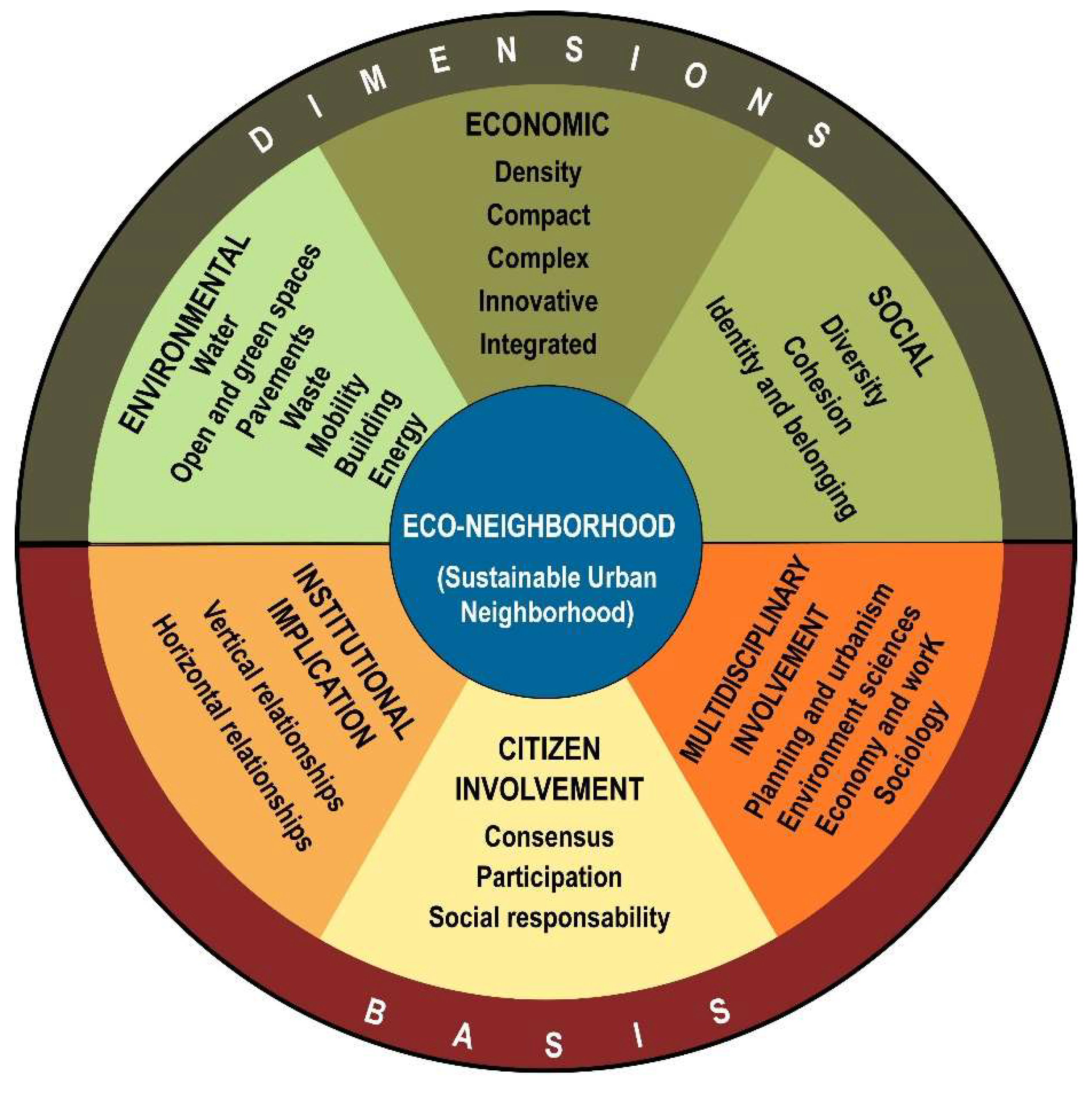
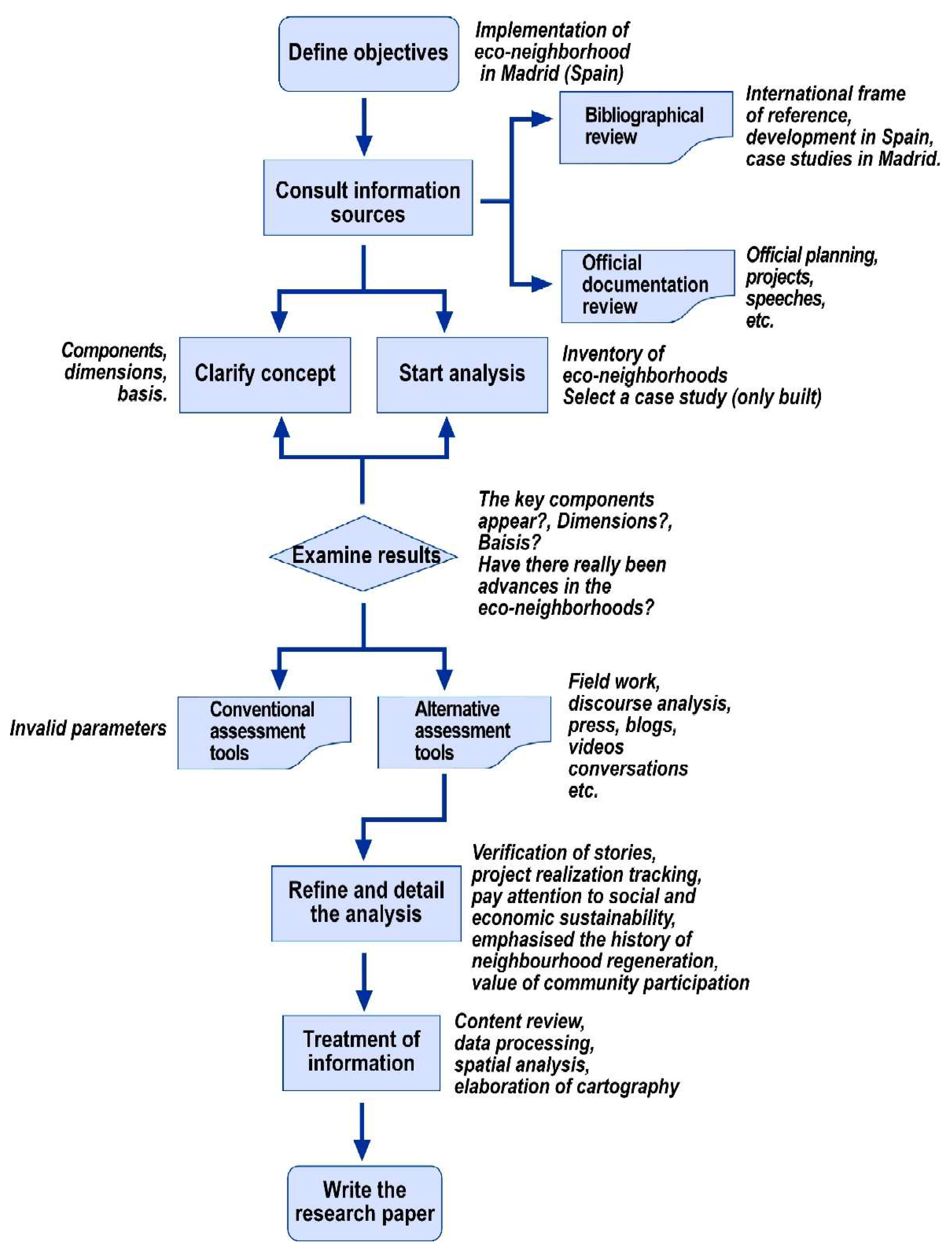


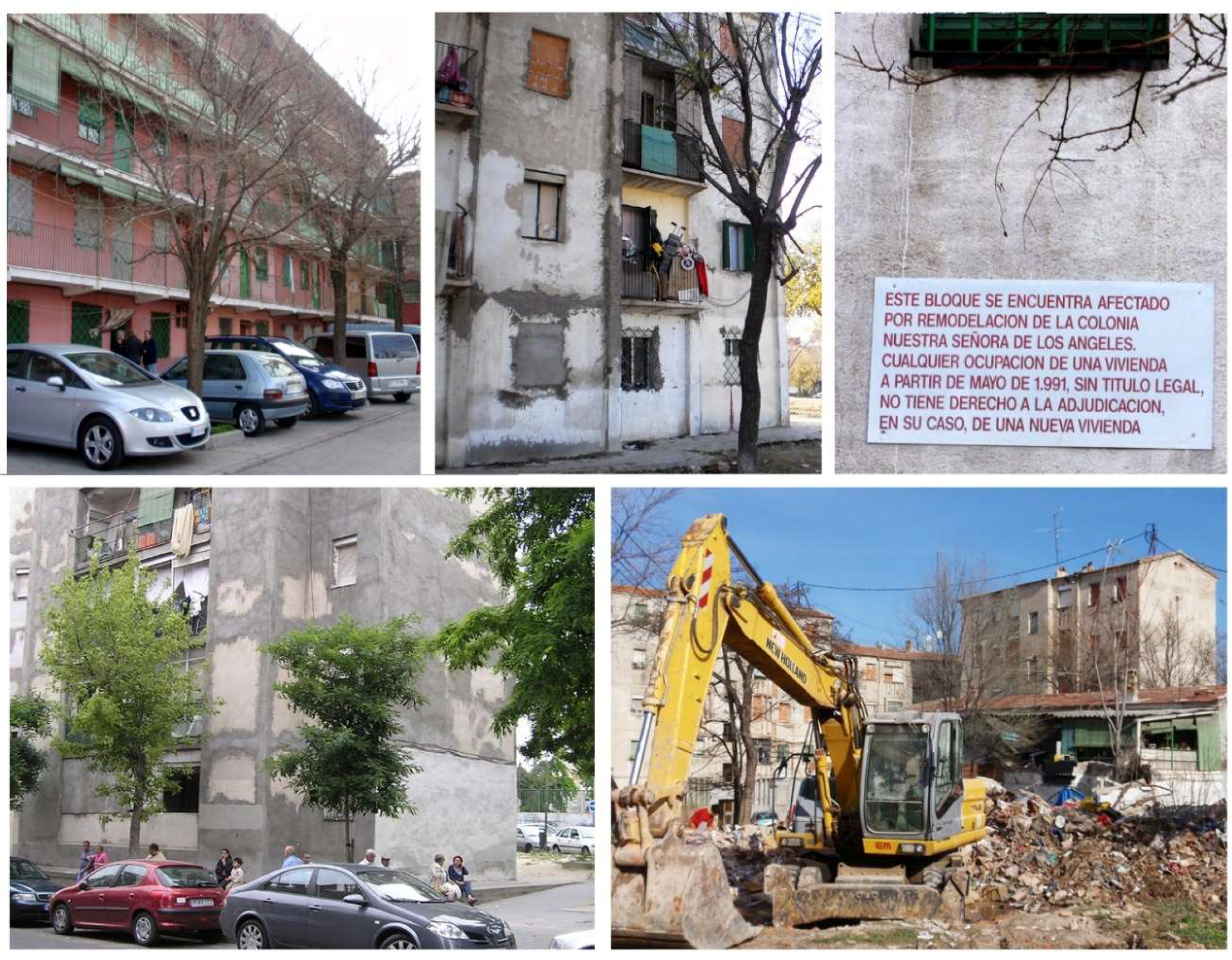
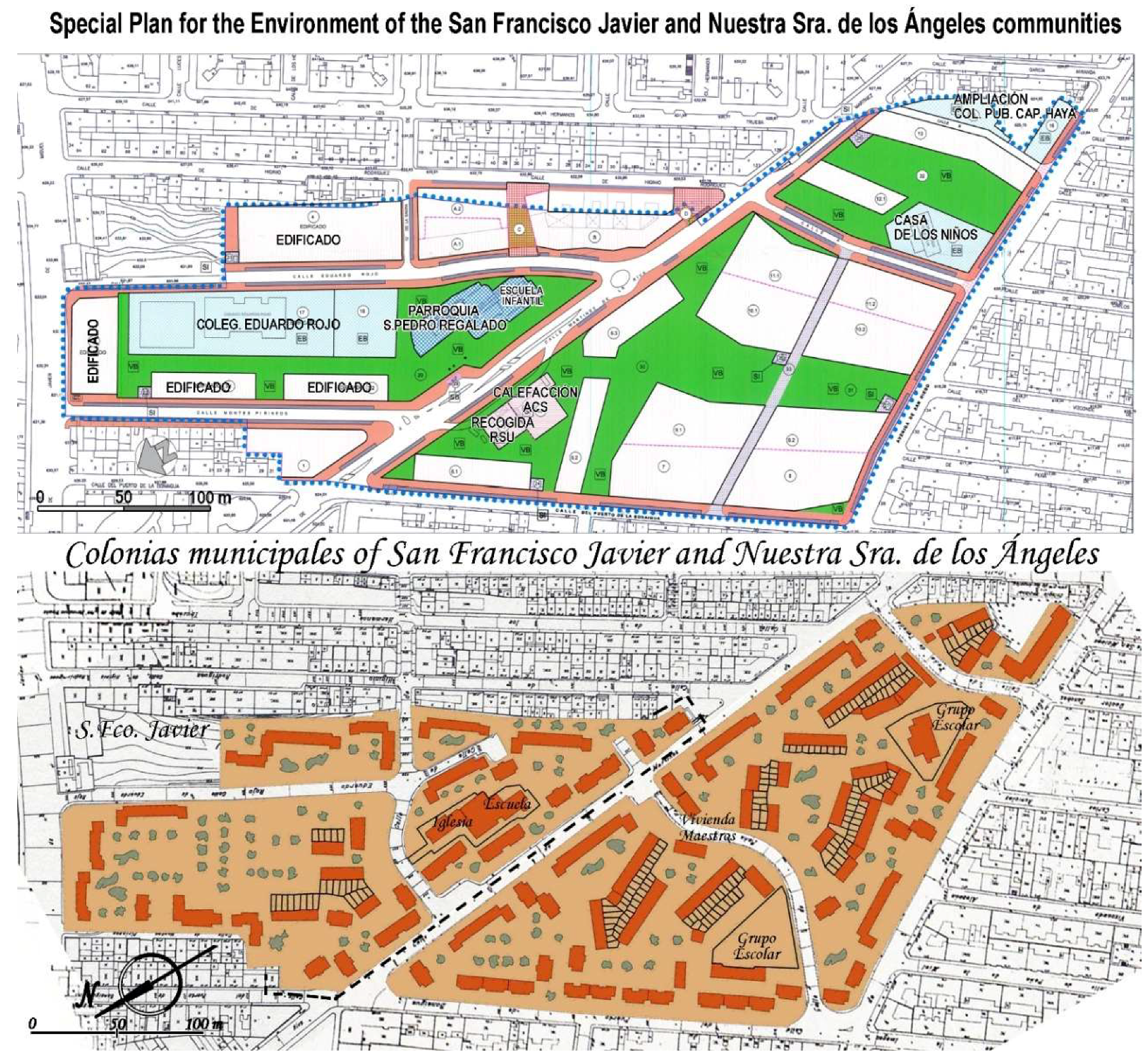
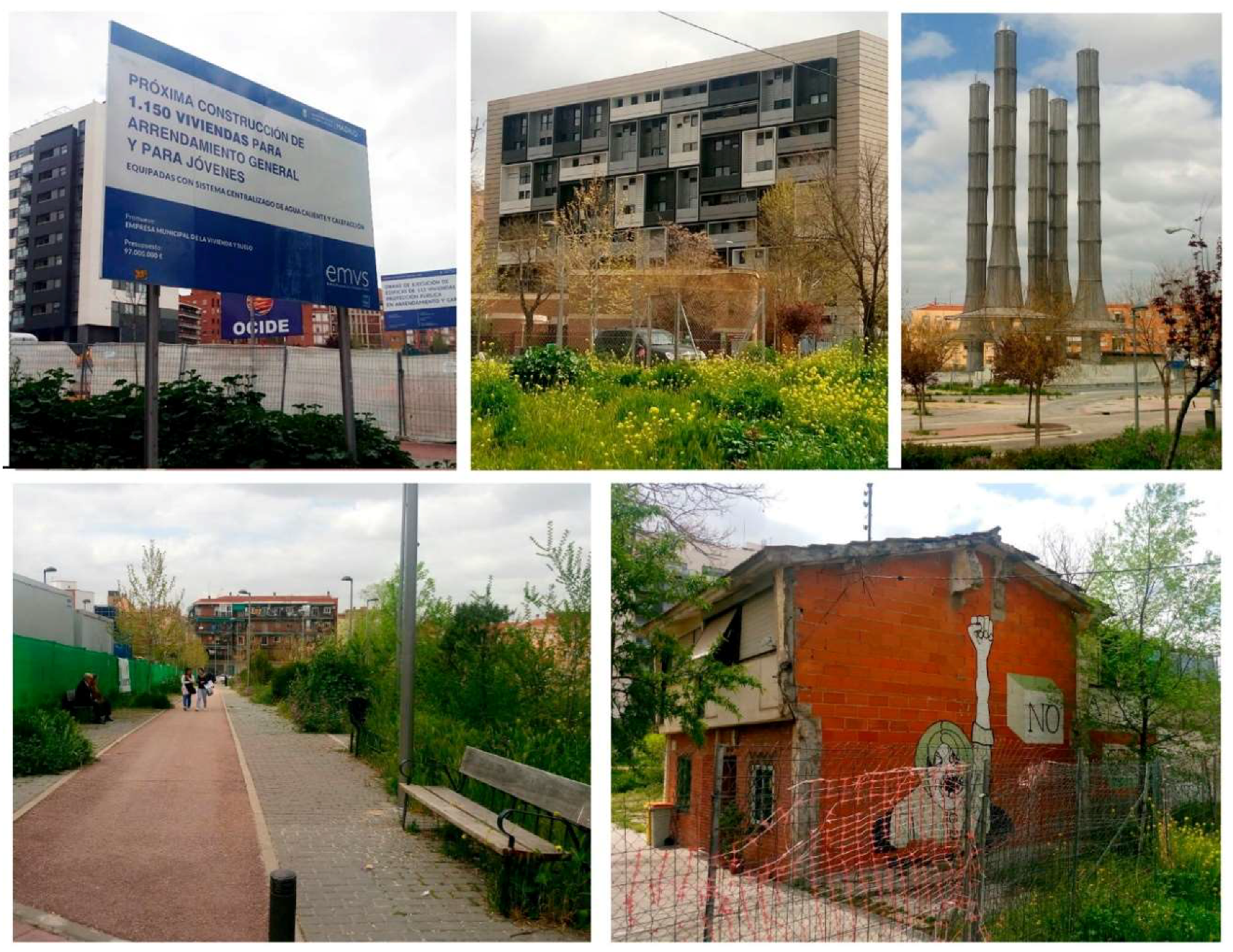
| Neighborhood | San Francisco Javier and Nuestra Señora de los Ángeles | Plata and Castañar | La Rosilla | Los Olivos | Lucero | Aeropuerto | |
|---|---|---|---|---|---|---|---|
| Projected eco-neighborhoods | Num. of dwellings | 2069 | 1600 | 400 | 336 | 324 | 540 |
| Surface area (Ha.) | 8.3 | 24.3 | 3.8 | 2.24 | 2.31 | 8.3 | |
| Prior neighborhoods | Type of original promotion | Municipal community | B.T.E. | B.T.E. | Municipal community | Municipal community | Private promotion—protected housing |
| Promotion date | 1957 | 1989 | 1989 | 1945 | 1955 | 1960 | |
| Promoter | Municipal Housing Board | IRIS | IRIS | Municipal Housing Board | Directorate General for Devastated Regions | Roiz S.A. | |
| Num. of dwellings | 1081 | 100 | 88 | 274 | 228 | 616 | |
| Start date (first demolitions) | 2007 | 2005 | 2005 | 2008 | Not started | Not started | |
| Land Use | Historical Municipal “Colonias” | Eco-Neighborhood 2006 | ||||||
|---|---|---|---|---|---|---|---|---|
| Colonia S.Fco.Javier | Colonia N.S. Ángeles | Total | ||||||
| Total | Surface Area (m2) | Total | Surface Area (m2) | Total | Surface Area (m2) | Total | Surface Area (m2) | |
| Residential (number of buildings) | 444 | 6122 | 639 | 13,160 | 1083 | 19,282 | 2069 | 31,147 |
| Multi-family | 420/28 blocks | 4879 | 476/27 blocks | 6145 | 896/55 blocks | 11,024 | 2069/20 blocks | 31,147 |
| Single-family | 24 | 1243 | 163 | 7015 | 187 | 8258 | 0 | 0 |
| Facilities | 1374 | 2754 | 4128 | 9831 | ||||
| Infrastructure | 1454 * | |||||||
| Green/open spaces | 23,090 | 28,519 | 51,609 | 19,790 | ||||
| Road | 2914 | 5641 | 8555 | 19,188 | ||||
| Main public road | 2712 | 2712 | 1651 | |||||
| Secondary public road | 2914 | 2929 | 5843 | 17,537 | ||||
| Parking area-pedestrian preferred street | 1040 | |||||||
| Parking area-garden area | 462 | |||||||
| Total | 33,500 | 50,074 | 83,574 | 82,912 | ||||
© 2018 by the authors. Licensee MDPI, Basel, Switzerland. This article is an open access article distributed under the terms and conditions of the Creative Commons Attribution (CC BY) license (http://creativecommons.org/licenses/by/4.0/).
Share and Cite
Canosa Zamora, E.; García Carballo, Á. The Failure of Eco-Neighborhood Projects in the City of Madrid (Spain). Urban Sci. 2018, 2, 111. https://doi.org/10.3390/urbansci2040111
Canosa Zamora E, García Carballo Á. The Failure of Eco-Neighborhood Projects in the City of Madrid (Spain). Urban Science. 2018; 2(4):111. https://doi.org/10.3390/urbansci2040111
Chicago/Turabian StyleCanosa Zamora, Elia, and Ángela García Carballo. 2018. "The Failure of Eco-Neighborhood Projects in the City of Madrid (Spain)" Urban Science 2, no. 4: 111. https://doi.org/10.3390/urbansci2040111
APA StyleCanosa Zamora, E., & García Carballo, Á. (2018). The Failure of Eco-Neighborhood Projects in the City of Madrid (Spain). Urban Science, 2(4), 111. https://doi.org/10.3390/urbansci2040111




